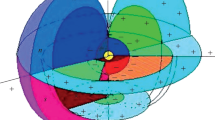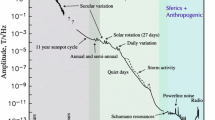Abstract
Two methods axe considered to “tap” the earths' rotational energy. This ancient “collapsed gravitational energy” exceeds the earth-lunar binding energy. One involves an orbiting “electromagnetic-gravitational” coupling system whereby the earth's rotation, with its nonuniform mass distribution, first uses gravity to add orbital energy to a satellite, similar to a planetary “flyby.rd The second stage involves enhanced satellite “drag” as current-carrying coils withdraw the added orbital energy as they pass through the earth's nonuniform magnetic field. A second more direct method couples the earth's rotational motion using conducting wires moving through the noncorotating part (ionospheric current systems) of the geomagnetic field. These methods, although not immediately feasible, are considerably more efficient than using pure gravitational coupling to earth-moon tides.
Similar content being viewed by others
References
Morabito, L. A., Synnott, S. P., Kupferman, P. N., and Collins, S. A. (1979).Science,240, 972.
Peale, S. J., Cassen, P., and Reynolds, R. T. (1970).Science,230, 892.
Ness, N. F., Acuna, M. H., Lepping, R. P., Burlaga, L. F., Behannon, K. W., and Neu-bauer, F. M. (1979).Science,204, 982.
Gold, T. (1979).Science,206, 1070.
Jackson, J. P. (1962).Classical Electrodynamics (John Wiley & Sons, London), 2nd ed.
Kaula, W. M. (1965).The Space of the Earth, in Introduction to Space Science, ed. Hess, W. N. (Gordon and Breach, New York), p. 297.
Kaula, W. M. (1966).Theory of Satellite Geodesy (Blaisdell Publishing Co., Waltham Massachusetts).
Kaula, W. M. (1962). “Celestial Geodesy,” NASA Tn D-1155.
Chapman, S., and Bartels, J. (1940).Geomagnetism, Vols. I and II (Oxford ùniversity Press, London, first published 1940, rev. 1962).
“Solar Power System, Concept Development and Evaluation Program” (1978). U.S. D.O.E./ER-0023, p. B61.
Author information
Authors and Affiliations
Rights and permissions
About this article
Cite this article
Schatten, K.H. Electromagnetic-gravitational energy systems. Gen Relat Gravit 13, 561–567 (1981). https://doi.org/10.1007/BF00757242
Received:
Issue Date:
DOI: https://doi.org/10.1007/BF00757242




